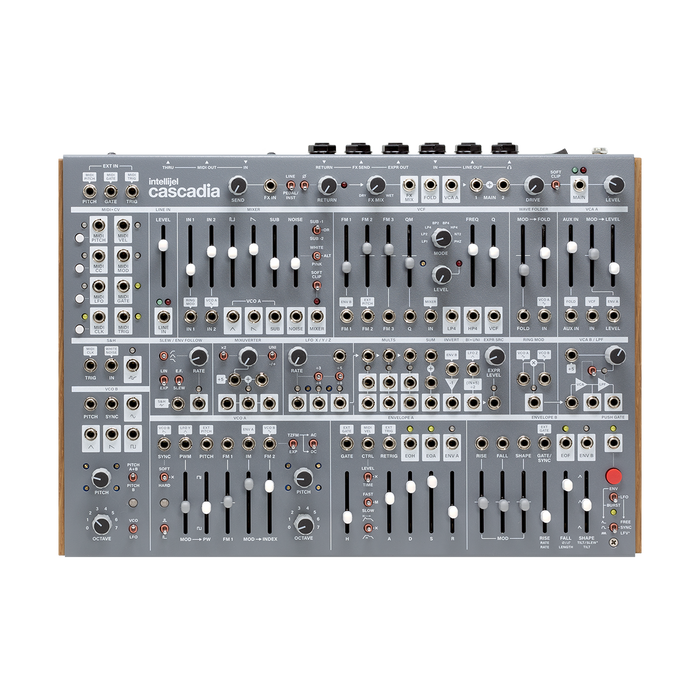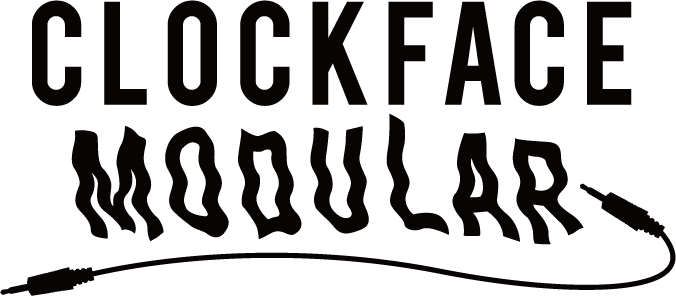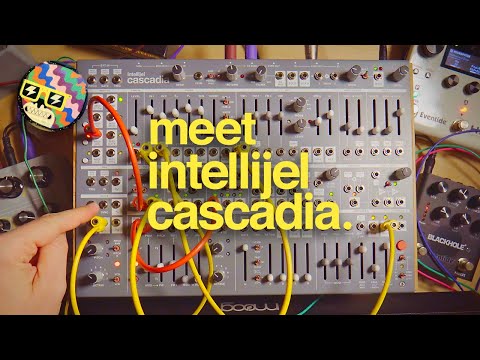MUSICAL FEATURES
Cascadia integrates East Coast and West Coast styles with rich features and deep, flexibleA performance-oriented semi-modular synthesizer.Intellijel's years of modular synth work have been rolled up into one package of sonic possibilities.
Cascadia makes many features natural for musicians without having to insert a single patch cable. Cascadia's default signal path is well thought out,For those who want to go deeper, rerouting the signal through many patch points opens up new possibilities for sound.
There is no omission of functions that are common in semi-modular synths, and each section is equipped with switches and many inputs and outputs, allowing users to use a wide variety of synthesis and modulation options.In particular, the utility section in the middle row is a collection of selected optional functions, and by mastering these, you will be able to use it far beyond the boundaries of the semi-modular.
We wanted Cascadia to be as flexible as possible, so instead of having onboard effects, we gave it the ability to fully integrate and control external effects devices.This allows you to incorporate your favorite pedal anywhere in your signal chain.And since the voltage is Eurorack compliant, external modules can be used to further expand Cascadia's capabilities.
Panel configuration and features
-
Two precision analog VCOs (VCO A / VCO B):
VCO Ais thru-zero FM capable with dedicated index VCA, sub-oscillator, PWM and soft/hard sync.VCO Bis a VCO/LFO combo with four simultaneous outputs.
-
6-channel waveform mixer section (MIXER):
External input is also possible for the two inputs.Built-in noise generator with multiple algorithms.Mix output with optional asymmetric soft clipping
-
Cascading 4-pole multimode filter (VCF) with liquid-like sound:8 modes: LP1, LP2, LP4, BP2, BP4, HP4, NT2, Phazor. With dedicated outputs for LP4 and HP4.Input level knob.Multiple FM and QM inputs with attenuators.
-
Wave Folder circuit:
West Coast style parallel wave folder.Normalized to the auxiliary input of the VCA in parallel with the filter.
-
Dual Digital Envelope (ENVELOPE A / ENVELOPE B):
ENV Ais a versatile east coast style ADSR/AHDSR envelope generator with hold function and dynamic level/time control. Normalized to VCA and FM indexes, you can shape your sound in no time.
ENV Bis a complex multi-mode function generator with West Coast-style AR/ASR/cycling AR, beat-syncable LFO, and burst generator mode.Normalized to the filter, instant FM is possible without patching.
-
VCA and output path (VCA A):
VCA A is a linear VCA with auxiliary inputs.It then passes through a global output mixer with overdrive circuitry and bypassable asymmetric soft clipping.
-
Utility section:A substantial utility section unique to Cascadia.By making good use of this, you will be able to create countless variations in timbre and sound movement.
-
S&H: A sample-and-hold circuit with white noise normalized to the input.
-
SLEW/ENV FOLLOW: Thru/envelope follower.
-
MIXUVERTER: Attenuator/mixer with multiple outputs.
-
LFO X/Y/Z: Triple triangle LFO with rate control, rate input and divide output.
-
MULTS: Triple buffered multiple.
-
SUM: Precision Adder.
-
INVERT: signal inverter.
-
BI+UNI: Bipolar > Unity Level Shifter.
-
EXPR SRC: Expression level control for modulating the TRS expression input of the FX pedal.
-
RING MOD: ring modulator.
-
VCA B/LPF: Combined auxiliary VCA and 4-pole diode ladder VCF for additional dynamics.
-
Upper section:
- easily accessiblepitch, gate input
-
Pedal Send & Return FX LoopSection with wet/dry control, phase inverter and line/pedal level switch.
- Output mixer with overdrive.
- Eurorack level for interfacing with other modular gearmain outputとlevel control
-
MIDI > CV section:
Converts MIDI signals input from the back into 8 assignable CVs and outputs them.Flexible settings are also possible from the dedicated app. LFO and CLK can be used even if MIDI is not connected.
- MIDI pitch/velocity output and Learn button
- MIDI Gate/Trig output
- MIDI CC/Mod output can be assigned to any CC with the Learn button
- MIDI LFO — Multimode LFO synchronized to MIDI clock or tap clock by corresponding button
- MIDI CLK can be divided.It can also be used as a tap clock with the corresponding button.
-
Rear panel:
-
1/4 inchstereo headphone jack
-
1/4 inchLine level balanced output
- ¼” balanced input (wired to on-panel Line In) for Cascadia processing of external line level
- 1/4" TS pedal effects send/return jack and 1/4" TRS expression output
- MIDI DIN In/Out/Thru and USB-MIDI
How To Use
The notation of the panel is as follows.
- White sliders are for direct control of parameters, gray are attenuators or attenuverters.In the case of Attenuvata, a line indicating the 0 position is written at the center position of the slider
- Jacks that are highlighted are outputs and those that are not are inputs.
- Input jacks with callouts are internally wired with the voltage from the output written inside the callout when unpatched.
- For close jacks, internal connections may also be indicated by arrows.
Internal wiring allows Cascadia to produce sounds without patching and can be controlled by a CV/Gate sequencer or keyboard.By patching the PITCH and GATE of EXT IN on the upper left of the main unit, the synth voice sound composed of internal connections will be output from the LINE OUT on the rear panel and the MAIN OUT on the upper right.
And Cascadia can dramatically increase the possibilities of sound creation through patching.Packed with a mix of classic East Coast and West Coast synthesizer blocks, let your imagination run wild and patch modules any way you like.It's up to you to make small changes to the architecture or make big changes to Cascadia's overall routing.
Interface
The panel configuration has sliders on the top and bottom, and a section with jacks as the main section in the center.This reduces the amount of patch cable interference when working with sliders, which can greatly improve performance.
The explanation of each part is displayed by mouse over
MIDI Config App
Various aspects of Cascadia's MIDI functionality can be customized using the Intellijel Config app (available for both Mac and Windows).The app can be downloaded from the Intellijel website.

System Region
The left column with a red background is the system area, used to select and connect the desired Intellijel MIDI device (Cascadia for now).It also imports and exports various saved settings.From top to bottom, the following options are available:
- MIDI Input: Select the MIDI device you want to configure from the dropdown MIDI input list.
-
MIDI Output: Select the MIDI device you want to configure from the drop-down MIDI output list.Note: Cascadia must be selected in both the MIDI In and MIDI Out menus to enable two-way communication between your computer and Cascadia.
-
Connect/Disconnect: Click this button to connect to the device selected in the MIDI Input and MIDI Output menus.Once connected, this button will change to a "Disconnect" button.
-
Refresh Devices: With the Intellijel Config app disconnected from any device, click this to refresh the list of available MIDI devices provided in the MIDI Input and MIDI Output columns.
-
Update from Device: Click to query the device.This is useful, for example, when configuring MIDI functionality on the Cascadia itself while connected to the Intellijel Config app. Pressing the Update from Device button will bring up the Intellijel Config app again with the latest settings from your device.
-
Amount: Click this button to import (load) a different Cascadia .xml format system configuration from disk.System settings can be saved to disk using the Export button.
-
export: Click this button to export (save) your current Cascadia system settings as an .xml file on your computer.
-
Reset Settings To Defaults: Click this button to reset Cascadia to factory default settings.
When performing a factory reset on the main unit, follow the steps below.
Power off Cascadia.
Press and hold the MIDI CLK button while powering Cascadia back on.
Cascadia will return to its factory state, resetting all assignable parameter options to default.
Config Region
Use the Cascadia Config column on the right (white background) to configure various MIDI and synth-related parameters for Cascadia selected in the System Region's MIDI Input and MIDI Output menus.The top of the column displays the name and current firmware version of the selected device.Below are all available parameters divided into several sections.
- MIDI Voice: Set Cascadia's MIDI channel, note priority, pitch bend range, tuning, and trigger length.
- MIDI CC Output: Set output type, CC number, CV polarity, etc.
- MIDI MOD Output t: Set output type, CC number, CV polarity, etc.
- MIDI LFO: Sets LFO shape, clock division
- MIDI/Tap Clock: Sets the clock mode and clock division.
- MIDI Out Config: Sets whether to output tap clock on MIDI Out and USB MIDI Out.
- Synth (Advanced): Advanced settings like Env B Burst Shape, EnvB LFO SYNC Rates, Envelope Stage Outputs, Alt Noise Type








